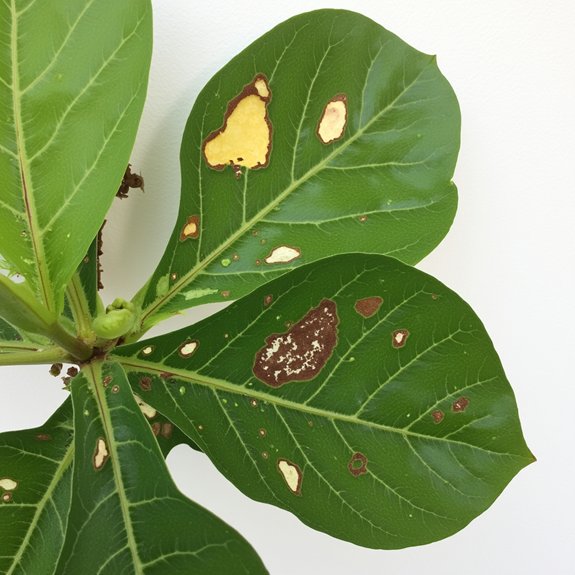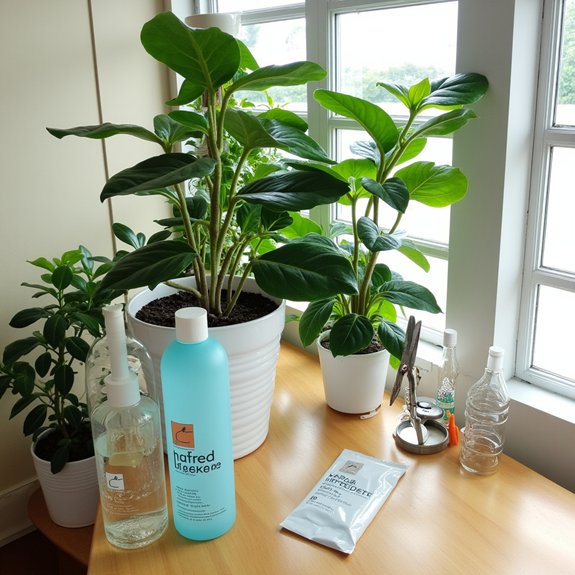Fiddle leaf fig owners often discover mysterious holes appearing overnight in their prized plant’s glossy leaves, transforming perfect foliage into what looks like green Swiss cheese. These perforations typically measure between 2-5mm in diameter and appear randomly across leaf surfaces, leaving plant parents puzzled and concerned. The culprits behind this botanical mystery range from nearly invisible pests to environmental factors that most people overlook completely, creating a complex puzzle that requires careful detective work to solve.
Contents
- 1 Common Causes Behind Leaf Perforation
- 2 Physical Damage and Environmental Stress Factors
- 3 Identifying Pest Infestations and Warning Signs
- 4 Diagnostic Methods for Determining Root Causes
- 5 Effective Treatment and Recovery Strategies
- 6 Prevention Techniques for Healthy Foliage
- 7 Long-term Care Practices for Optimal Plant Health
Common Causes Behind Leaf Perforation

Several distinct factors contribute to the frustrating appearance of holes in Fiddle Leaf Fig leaves, each requiring different identification and treatment approaches. Physical damage ranks as the primary culprit, especially when plants sit in high-traffic areas where contact weakens the leaf structure. Low humidity below 40% creates brittle foliage that tears easily, particularly affecting young leaves during development.
Pest infestations, including spider mites and caterpillars, systematically damage leaves while disrupting nutrient absorption. Environmental stress from inconsistent watering or poor light conditions further compromises leaf integrity, making perforation inevitable.
Physical Damage and Environmental Stress Factors
Physical trauma represents the most immediate threat to Fiddle Leaf Fig foliage, occurring when leaves brush against walls, furniture, or passing traffic in busy household areas. Older leaves become particularly vulnerable due to their size and exposed positioning. Environmental conditions amplify this vulnerability considerably.
High light exposure combined with insufficient watering creates brittle, paper-thin leaves that tear easily during routine care activities. Leaf stress intensifies when humidity levels drop below 40%, causing foliage to lose flexibility and resilience. Even gentle wiping or watering can damage compromised leaves, creating irregular holes and tears that cannot heal naturally.
Identifying Pest Infestations and Warning Signs

When holes begin expanding rather than remaining static, pest activity becomes the likely culprit behind the damage. Effective pest identification requires examining leaf undersides, stems, and soil surfaces for telltale signs. Spider mites leave fine webbing, while mealybugs create white, cotton-like residue on stems and leaf joints. Caterpillars often hide during daylight hours, making evening inspections more productive.
Key infestation signs include sticky honeydew deposits, brown or yellow stippling patterns, and small moving specks on foliage. Fresh holes appearing weekly indicate active feeding, requiring immediate intervention to prevent widespread plant damage.
Diagnostic Methods for Determining Root Causes
Beyond identifying visible pest evidence, determining the actual cause behind fiddle leaf fig holes requires systematic investigation across multiple plant care factors. Start with thorough leaf inspection, examining both upper and lower surfaces for webbing, discoloration, or tiny insects. Check soil moisture levels by inserting your finger two inches deep.
Conduct moisture assessment weekly, noting if soil stays soggy or becomes bone-dry. Evaluate humidity using a digital meter, aiming for 40-60%. Review your watering schedule, fertilization routine, and recent plant movements. Document light exposure duration and intensity. This methodical approach reveals whether holes stem from pests, environmental stress, or care inconsistencies.
Effective Treatment and Recovery Strategies

Implementing targeted solutions immediately after diagnosing the root cause maximizes recovery success for damaged fiddle leaf figs. Treatment options vary based on the specific issue identified. For pest infestations, apply insecticidal soap or neem oil every 3-5 days until bugs disappear completely.
Physical damage requires relocating plants away from high-traffic areas, while humidity problems need immediate environmental adjustments. Recovery techniques include maintaining 50-60% humidity levels and consistent watering schedules. Remove severely damaged leaves with clean pruning shears to redirect energy toward healthy growth. Most fiddle leaf figs show improvement within 2-4 weeks when proper solutions are applied consistently.
Prevention Techniques for Healthy Foliage
Maintaining proper care routines prevents most leaf damage before it starts, saving fiddle leaf fig owners from costly recovery efforts. Regular inspection catches problems early, allowing quick intervention before holes develop. Humidity levels should stay above 40% using humidifiers or pebble trays filled with water. Quality soil with proper drainage prevents root issues that weaken leaves. Consistent watering schedules based on soil moisture, not calendar dates, keep plants stable. Position plants away from high-traffic areas where accidental bumping occurs. Rotate weekly for even light exposure, preventing weak spots that tear easily.
Long-term Care Practices for Optimal Plant Health
While prevention techniques provide immediate protection, successful fiddle leaf fig care requires a long-term approach that addresses the plant’s evolving needs over months and years. Establishing consistent watering frequency becomes essential, as mature plants require different moisture levels than younger specimens. Monitor soil moisture weekly, adjusting schedules seasonally when growth patterns shift. Soil quality deteriorates over time, requiring annual repotting with fresh, well-draining potting mix. Regular fertilization during growing seasons supports robust leaf development. Position changes may become necessary as the plant grows taller, ensuring adequate light reaches all foliage levels for sustained health.
